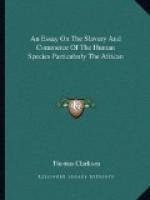The argument therefore, which is brought against the hypothesis, is so far from being, an objection, that we shall consider it one of the first arguments in its favour: for if climate has really an influence on the mucous substance of the body, it is evident, that we must not only expect to see a gradation of colour in the inhabitants from the equator to the poles, but also different[085] shades of the same colour in the inhabitants of the same parallel.
To this argument, we shall add one that is incontrovertible, which is, that when the black inhabitants of Africa are transplanted to colder, or the white inhabitants of Europe to hotter climates, their children, born there, are of a different colour from themselves; that is, lighter in the first, and darker in the second instance.
As a proof of the first, we shall give the words of the Abbe Raynal[086], in his admired publication. “The children,” says he, “which they, (the Africans) procreate in America, are not so black as their parents were. After each generation the difference becomes more palpable. It is possible, that after a numerous succession of generations, the men come from Africa would not be distinguished from those of the country, into which they may have been transplanted.”
This circumstance we have had the pleasure of hearing confirmed by a variety of persons, who have been witnesses of the fact; but particularly by many intelligent[087] Africans, who have been parents themselves in America, and who have declared that the difference is so palpable in the northern provinces, that not only they themselves have constantly observed it, but that they have heard it observed by others.




